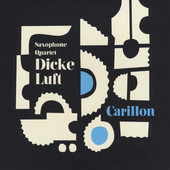Vier saxofoons spelen als strak in elkaar grijpende radartjes van een uurwerk.
 Onlangs kwam de CD CARILLON uit van saxofoonquartet Dicke Luft (red piano records). Carillon is een compositie in 12 delen van saxofonist Dick de Graaf, op het grensgebied van tonale en atonale muziek en van gecomponeerde muziek en jazz.
Onlangs kwam de CD CARILLON uit van saxofoonquartet Dicke Luft (red piano records). Carillon is een compositie in 12 delen van saxofonist Dick de Graaf, op het grensgebied van tonale en atonale muziek en van gecomponeerde muziek en jazz.
De tijd speelt een grote rol in het leven. We proberen hem soms te vergeten of stil te zetten, maar we maken hem ook zichtbaar, tastbaar en hoorbaar door uurwerken.
In Carillon hoor je overal uurwerken lopen. Fascinerende machines die alleen maar werken als alle onderdelen perfect met elkaar samenwerken. Zoals de saxofonisten dat ook doen in dit kwartet. De thema’s, melodielijnen en ritmische riffs grijpen strak in elkaar.
Heuer: Een opgewonden en optimistisch spelletje met majeur en mineur klanken met een bluesy ondertoon
Het stuk is geïnspireerd op de methode De Toonklok van componist Peter Schat.
Van hem was het idee om een carillon te schrijven, voor elk uur gebruik makend van het bijbehorende uur uit zijn Toonklok. (zie onder)
Dick de Graaf vertaalde dit idee naar 12 korte riff-achtige melodieën en improvisaties die steeds gebaseerd zijn op een van zijn 12 uren. Die Toonklok bleek nieuwe mogelijkheden te bieden om compositie en improvisatie met elkaar te verbinden.
Onsa: Zwitsers horloge met datum blonk uit doordat het zo ‘plat’ gebouwd was en doordat de secondenwijzer niet per seconde bewoog maar in een bijna vloeiende beweging ronddraaide.
De titels van de 12 delen verwijzen naar uurwerken waaraan De Graaf goede herinneringen heeft; merken van horloges (Swatch, Omega, Seiko enz.) die een rol speelden in zijn leven, het dromerige geklepel van een torenklokje in de Franse Ardennen en de stoere luidklok van de Dom in Keulen.
Het Dicke Luft saxofoon quartet: Arno Bornkamp – sopraan, Werner Janssen – alt, Nils van Haften – bariton en Dick de Graaf – tenorsax (de musici vormen samen ook de saxofoonsectie van het Clazz Ensemble).
Emporio Armani: Elegantie en lichtheid zijn de kenmerken van dit stuk,
Dicke Pitter: Een strengere, zwaardere atmosfeer. De Dom van Keulen en zijn luidklokken dienden als inspiratie voor dit deel. Het eerste deel verraadt bouwactiviteiten. Raderen van uurwerken passen precies in elkaar. In het volgende snelle gedeelte is klokgelui hoorbaar als begeleiding van de saxsolo.
Peter Schat
Ontwikkelde hij zich als componist in de jaren vijftig. Hij begon, zoals velen in die tijd, met componeren via structurele processen. Later zou hij juist meer de werking tussen de emotie van de componist en zijn publiek vertalen in zijn werk. Schat was in de jaren zestig actief geëngageerd in bewegingen voor maatschappelijke hervorming. Aan het eind van de jaren zestig verstomde dit en begonnen zijn werken meer verwijzingen naar muziekstijlen uit het verleden te vertonen; eerst ironisch bedoeld, later meer vanuit het historische oogpunt. In de loop der jaren zeventig deed hij afstand van het muzikale modernisme.
De Toonklok
Een compositiesysteem, dat op drieklanken was gebaseerd. Onder drieklank wordt verstaan iedere mogelijke combinatie van drie intervallen. De definitie van drieklank is in deze duidelijk een andere dan de tot op dat moment gangbare. De akkoorden in de diatonische harmonie zijn immers opgebouwd uit tertsenstapelingen; de terts is dus de kleinste harmonische eenheid. Schat maakte de kleine secunde tot kleinste harmonische eenheid, waardoor er opeens veel meer en anders klinkende drieklanken konden bestaan. zie ook dit artikel
 Dick de Graaf is sopraan- en tenorsaxofonist, en docent aan het Rotterdamse Conservatorium.
Dick de Graaf is sopraan- en tenorsaxofonist, en docent aan het Rotterdamse Conservatorium.
Zijn eerste plaat kwam uit in 1986, en sindsdien heeft hij vele bands en projecten geleid.
Dicke Luft is het meest recente ensemble.
Andere huidige projecten zijn een solo programma ‘Bach Reflections’, met Bachs eerste cellosuite, waarbij hij ook improviseert
. Mede-oprichter en artistiek leider van het 12-koppige Clazz ensemble (Klassiek meets jazz)
‘Out of the Blues”, waarin met een trio de muziek wordt gespeeld van saxofonist Oliver Nelson.
ENGLISH VERSION
Four saxophones play as tightly interlocking cogs of a clock .
Recently released: CD CARILLON (red piano records) by saxophone quartet Dicke Luft.
Carillon is a composition of 12 parts by saxophonist Dick de Graaf, crossing the border of tonal and atonal music and composed music and jazz .
Time plays a major role in life. We sometimes try to forget it or make it stop, but we also make it visible, tangible and audible in clockworks.
In Carillon you can hear running clocks everywhere. Fascinating machines that only work if all the parts work together perfectly. As the saxophonists do in this quartet. Themes, melodies and rhythmic riffs grab tight.
The piece is inspired by the Tone Clock method of composer Peter Schat. His idea was to write a carillon for each hour using the corresponding hour of his Tone Clock. (see below)
Dick de Graaf translated this idea into 12 short riff -like melodies and improvisations, based on one of his 12 hours. This Tone Clock proved to connect composition and improvisation with new opportunities
The titles of the 12 parts refer to good memories that Dick de Graaf has; brands of watches (Swatch, Omega, Seiko, etc.) that played a role in his life, the dreamy sound of a tower clock in the Ardennes and the tough loud bell of the Cologne Cathedral. The Dicke Luft saxophone quartet: Arno Bornkamp – soprano, Werner Janssen – alto, Nils van haften – baritone and Dick de Graaf – tenor sax (the musicians together also form the saxophone section of the Clazz Ensemble ) .
Emporio Armani : Elegance and lightness are the characteristics of this piece ,
Peter Schat
developed as a composer in the fifties. He began, like many at that time, composing through structural processes. Later on he tried to make more of a translation between the emotion of the composer and his audience in his work. In the sixties he became actively engaged in movements for social reform. At the end of the sixties this diminished and his work began to show more references to music from the past, first in an ironic way, later on from a historical perspective. Throughout the seventies he renounced the musical modernism.
The Tone Clock
A composition system that was based upon Triads. A triad is defined as any combination of three intervals. The definition of the triad is in this toneclock was clearly different from the conventional one up to that time. The chords in the diatonic harmony are made up of thirds; the third is the smallest harmonic unit. Peter schat made the minor second to the smallest harmonic unity, because of which suddenly many more and different sounding triads could exist.
Dick de Graaf is soprano and tenor saxophonist, and works as ateacher at the Rotterdam Conservatory. His first album came out in 1986, and since then he has led numerous bands and projects. Dicke Luft is the latest ensemble. Other current projects include a solo program “Bach Reflections’, with Bach’s first cello suite, in which he improvises as well. Co-founder and artistic director of the 12-member ensemble Clazz (Classical meets jazz). ” Out of the Blues “, a trio celebrating the music saxophonist Oliver Nelson .